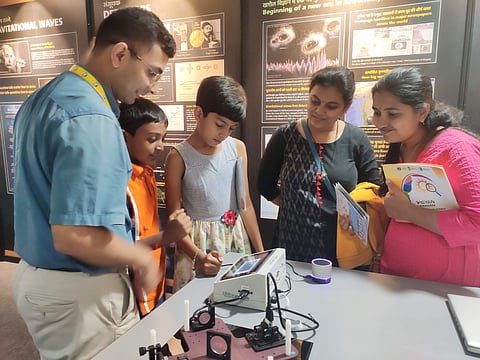

If you are one of those people who thinks that Science can only lead to a career either in Engineering or Medicine, then your belief is far from the truth. There's an endless list of career opportunities out there where you can utilise your Science degree. Vigyan Samagam, a travelling exhibition at Visvesvaraya Technological and Industrial Museum is one such place that will prove to you that there are bigger research projects coming up in India and around the world. Organised by the Department of Atomic Energy, Department of Science and Technology, National Council of Science Museums and the Ministry of Culture, this exhibition started its journey in Mumbai in May 2019. This September, Bengaluru will be its home before it moves on to Kolkata and Delhi for two months each to show young minds how they can be part of some of those bigger projects and contribute to international research projects representing India.
K Madan Gopal, Director of VITM, sees this as a great opportunity for students to witness projects related to Astronomy, the Big Bang Theory, Gravitational Force and much more. He says, "After the exhibition is completed at Delhi, every model will be sent to CERN, the European Organization for Nuclear Research in Geneva. The projects that have been put up in this exhibition are ongoing scientific research projects in different countries around the world and India will be contributing to all of them. All these projects will be completed only by 2025. It was CERN that partnered with six other organisations including Laser Interferometer Gravitational-Wave Observatory (LIGO), Facility for Antiproton and Ion Research (FAIR), International Thermonuclear Experimental Reactor (ITER), India-based Neutrino Observatory (INO), Square Kilometre Array (SKA) and Thirty Meter Telescope (TMT) to tell people what they are doing currently."
The giant projects that are in the process
Hunting for Neutrinos
The India-based Neutrino Observatory (INO), which will be coming up at the Bodi West Hills in Pottipuram village of Theni district, is one of India's very ambitious projects. Alaika B G from the Central University of Karnataka, who is pursuing her PhD in Particle Physics, says, "This laboratory will play a key role in hunting an exclusive elementary particle called neutrino. There will be several detectors fixed to study the properties of the neutrino and the long-range interactions between neutrinos and dark matter annihilation occurring in the Sun. Students from various educational institutions including the Institute of Physics, University of Hyderabad, University of Mysore and so on will be involved in these projects. They will get to contribute to the research as well as find career options in this."
Wanna see gravitational waves?
The Laser Interferometer Gravitational-Wave Observatory (LIGO) will be set up in the Hingoli district of Maharashtra. While two observatories already exist in the United States, the third one in India will be working in coordination with the US. Vaibhav Savant, who is working closely with LIGO to educate students about their projects, says, "While the scientists proposed various theories about gravitational waves, none of them were able to prove their existence. On September 14, 2015, LIGO and 37 researchers from nine Indian institutions were successful in detecting the first gravitational waves and show them to the world. While two black holes of masses 36 and 29 Suns merged to form a 62 solar mass black hole, the rest of the mass was released as energy in gravitational waves. The observatory that is coming up in India will work towards the same goal. Since it is a multidisciplinary project, we will require students from various engineering backgrounds to work with us in Hingoli. It includes Engineering in Quantum Metrology, Laser Physics and Technology, Optical Engineering, Control Systems and much more. Aside from this, we are collaborating with 14 institutions and the International Centre of Theoretical Sciences in Bengaluru is one of them."
Discovering what's out there
Another exciting project is Thirty Meter Telescope that will be set up in Hawaii. Telescopes have always led to fascinating discoveries in Astronomy but this one is said to be the most advanced ground-based optical and infrared telescope to probe the unknown cosmos. Five nations, namely India, Canada, China, Japan and the USA, will be involved in building this one-of-a-kind, massive telescope. The single reflective surface which measures 30 metres in diameter will have 492 hexagonal mirrors providing light-gathering capability. While these mirrors are produced in Japan, the polishing will take place in India, and that too in namma Bengaluru. Not just the mirror polishing, India will also contribute to scientific instruments like actuators, edge sensors, software development and segment support assemblies. Indian Institute of Astrophysics in Bengaluru is one of the three institutes that is contributing to this project.
The target audience
Now, you might have questions about how students can be benefitted from this exhibition. With every project being displayed with colourful panels, audio and video display, current pictures of the Universe and life, a separate person to interact with participants at the kiosks, children can not only enjoy but also gain immense knowledge in this field. Since the exhibition is jointly run by six different organisations, there are a series of activities like quiz competitions, projects and learn through experiments for kids.
Crucial roles of Indian researchers in the collaboration
Bala Iyer from International Centre for Theoretical Sciences pioneered theoretical calculations used for modelling gravitational waves produced by orbiting black holes in the 1990s
C V Vishveshwara, in the 1970s, published studies that are crucial to test the validity of Einstein's theory using the 'ring down' signature of the resultant black hole
Sanjeev Dhurandhar, in the 1990s, pioneered the template bank-based 'Match Filtering' technique to identify gravitational waves in noisy data
